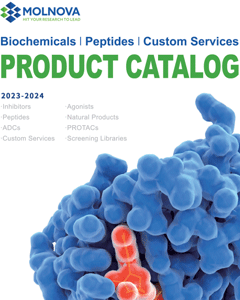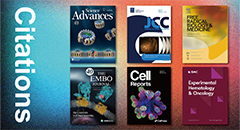
TFLLR-NH2(TFA)
CAS No. 1313730-19-6
TFLLR-NH2(TFA)( —— )
Catalog No. M30033 CAS No. 1313730-19-6
TFLLR-NH2 (TFA) is a selective PAR1 agonist with an EC50 of 1.9 μM. EC50: 1.9 μM (PAR1)
Purity : >98% (HPLC)
 COA
COA
 Datasheet
Datasheet
 HNMR
HNMR
 HPLC
HPLC
 MSDS
MSDS
 Handing Instructions
Handing Instructions
| Size | Price / USD | Stock | Quantity |
| 5MG | 640 | Get Quote |


|
| 100MG | Get Quote | Get Quote |


|
| 200MG | Get Quote | Get Quote |


|
| 500MG | Get Quote | Get Quote |


|
Biological Information
-
Product NameTFLLR-NH2(TFA)
-
NoteResearch use only, not for human use.
-
Brief DescriptionTFLLR-NH2 (TFA) is a selective PAR1 agonist with an EC50 of 1.9 μM. EC50: 1.9 μM (PAR1)
-
DescriptionTFLLR-NH2 (TFA) is a selective PAR1 agonist with an EC50 of 1.9 μM. EC50: 1.9 μM (PAR1)(In Vitro):PAR1 agonists stimulate concentration-dependent increases in [Ca2+]i and in the proportions of neurones. The maximal increase in [Ca2+]i above basal is detected in response to 10 μm TF-NH2 (peak 196.5±20.4 nM, n=25) when 50–80% of identified neurones responded. SW620 cells cultured in the supernatant of TFLLR-NH2-activated platelets upregulate E-cadherin expression and downregulate the vimentin expression. In the in vitro platelet culture system, a TFLLR-NH2 dose-dependent increase of secreted TGF-β1 is detected in the supernatant.(In Vivo):Injection of TF-NH2 into the rat paw stimulates a marked and sustained oedema. An NK1R antagonist and ablation of sensory nerves with capsaicin inhibit oedema by 44% at 1 h and completely by 5 h. In wild-type but not PAR1 / mice, TF-NH2 stimulates Evans blue extravasation in the bladder, oesophagus, stomach, intestine and pancreas by 2–8 fold. Extravasation in the bladder, oesophagus and stomach is abolished by an NK1R antagonist. TFp-NH2 produces notable contraction at 3-50 μM and relaxation at 0.3-50 μM, in the absence of apamin. The concentration-response curve for TFp-NH2-induced contraction is remarkably shifted left, when the TFp-NH2-induced relaxation is blocked by apamin at 0.1 μM.
-
In VitroPAR1 agonists stimulate concentration-dependent increases in [Ca2+]i and in the proportions of neurones. The maximal increase in [Ca2+]i above basal is detected in response to 10?μm TF-NH2 (peak 196.5±20.4?nM, n=25) when 50–80% of identified neurones responded. SW620 cells cultured in the supernatant of TFLLR-NH2-activated platelets upregulate E-cadherin expression and downregulate the vimentin expression. In the in vitro platelet culture system, a TFLLR-NH2 dose-dependent increase of secreted TGF-β1 is detected in the supernatant.
-
In VivoInjection of TF-NH2 into the rat paw stimulates a marked and sustained oedema. An NK1R antagonist and ablation of sensory nerves with capsaicin inhibit oedema by 44% at 1?h and completely by 5?h. In wild-type but not PAR1?/? mice, TF-NH2 stimulates Evans blue extravasation in the bladder, oesophagus, stomach, intestine and pancreas by 2–8 fold. Extravasation in the bladder, oesophagus and stomach is abolished by an NK1R antagonist. TFp-NH2 produces notable contraction at 3-50 μM and relaxation at 0.3-50 μM, in the absence of apamin. The concentration-response curve for TFp-NH2-induced contraction is remarkably shifted left, when the TFp-NH2-induced relaxation is blocked by apamin at 0.1 μM.
-
Synonyms——
-
PathwayGPCR/G Protein
-
TargetPAR
-
RecptorEC50: 1.9 μM (PAR1)
-
Research Area——
-
Indication——
Chemical Information
-
CAS Number1313730-19-6
-
Formula Weight761.83
-
Molecular FormulaC33H54F3N9O8
-
Purity>98% (HPLC)
-
SolubilityH2O : 100 mg/mL (131.26 mM; Need ultrasonic);DMSO : 100 mg/mL (131.26 mM; Need ultrasonic)
-
SMILES——
-
Chemical NameSequence:Thr-Phe-Leu-Leu-Arg-NH2
Shipping & Storage Information
-
Storage(-20℃)
-
ShippingWith Ice Pack
-
Stability≥ 2 years
Reference
de Garavilla L, et al. Agonists of proteinase-activated receptor 1 induce plasma extravasation by a neurogenic mechanism. Br J Pharmacol. 2001 Aug;133(7):975-87.
molnova catalog



related products
-
tcY-NH2
Selective PAR4 antagonist peptide. Inhibits endostatin release and platelet aggregation induced by thrombin.
-
Vorapaxar
A potent, selective and orally active thrombin receptor PAR-1 antagonist with Ki of 8.1 nM.
-
Protease-Activated R...
Protease-Activated Receptor-4 is the proteinase-activated receptor-4 (PAR4) ?agonist.



 Cart
Cart
 sales@molnova.com
sales@molnova.com


